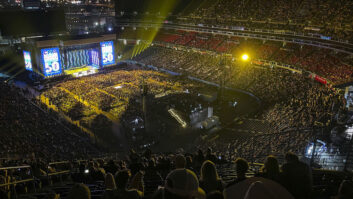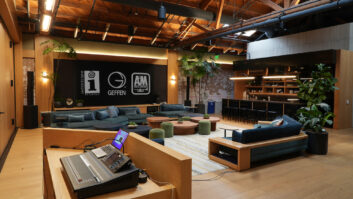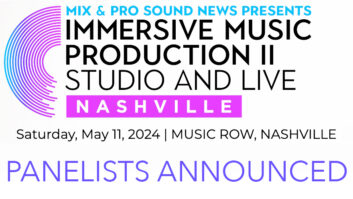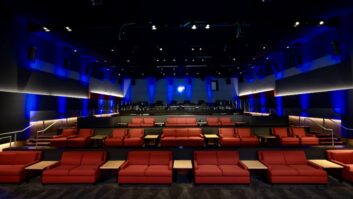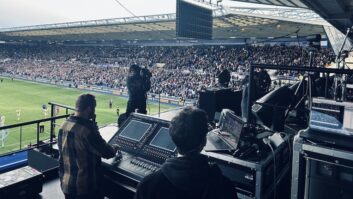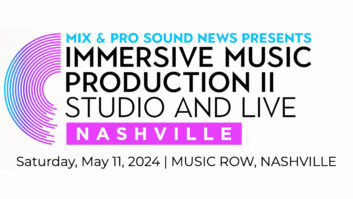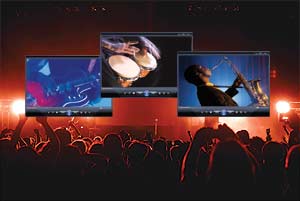
As the global economy speeds headlong to Doomsday, someone should get the memo to the live concert industry. Other indicators in the music business seem to be just down, down, down, but the latest statistics on concertgoers tell a different story.
When Live Nation, the world’s largest producer of live events, reported its 2008 fourth-quarter earnings, the numbers were both surprising and encouraging: promotion of almost 7,000 events with more than 13,000,000 attendees. For the whole year, the total was more than 22,000 events with more than 52,000,000 ticketholders. Both the quarter and the year overall represented double-digit gains over 2007. With the likes of Madonna, Coldplay, the Jonas Brothers, Nickelback and AC/DC all on tour in 2009, live sound may stay on the healthy side.
One of the ways that Live Nation acts, and thousands of other artists performing live every day, create such impressive buzz and revenue stems is from integrating evolving technology platforms. Touring and merchandising can represent lucrative revenue streams by themselves, but more and more bands, labels and promoters realize that any show that’s not captured on audio and/or video, and subsequently made available via the Web, broadcast or other means is a wasted opportunity to increase revenue and/or exposure.
A touring artist since the formation of his band Less Than Jake in 1992, drummer/Paper and Plastick record label founder Vinnie Fiorello has seen the expectations of live audiences evolve significantly. “Audiences are not only looking for the immediacy of being entertained, but because of advances in the Internet and the ability to cherry-pick the entertainment that they have, they’re looking for something after the fact,” he observes. “Not only are they going to see Less Than Jake at the [Baltimore venue] Ram’s Head tonight, but they’ll be looking on YouTube for live updates, live feeds and videos. It’s a very interesting position to be in as a band because you not only have to be prepared to play live, but have what you play live immortalized for people to see after the fact.
“As bandwidth becomes faster, people are looking for video. When all you had was a 56k modem, all you could get was audio. Now that you have a fast enough connection to stream video easily without any hookups, 15 to 17-year-olds are looking for video. If they like South Park, 90210 and Less Than Jake, they want to be able to pull that up at the drop of a hat. There’s a vast amount of entertainment out there from a few keystrokes. As a band, you have to keep up with that, provide it or be left behind.”
Hank Neuberger, president of Springboard Productions Inc., takes this attitude on the road for artists such as Smashing Pumpkins, Prince, Lenny Kravitz, Dave Matthews Band and scores more. Specializing in digital media production for broadband, broadcast, mobile, IPTV and Blu-ray DVD, Neuberger’s team is on hand to ensure that every desired means of distribution is covered once a gig’s last note has sounded.
Says Neuberger, a Grammy®-winning producer, “Just like I was doing in the recording studio, now I’m working with video and audio in a live setting where the audience is. I’m just making sure that our mission extends the impact of the artist and doesn’t get in the way of it on the path to these multiple formats.
“Every production is literally different, and what impacts the decisions we make and the communications we have with FOH and monitors are the deliverables, or the final windows of exhibition: Is it broadcast? Is it Webcast? Is it satellite radio? Is it downloadable video or audio only? Is it for movie theaters? There are so many options now, and they all require different solutions.”

Hank Neuberger (left) and TD Russ Rodriguez at Coachella video control
Neuberger and his team of video and recording engineers communicate closely with stage managers, and front-of-house and monitor engineers before deploying their technology to the concert site, which could include separate multitrack Digidesign Pro Tools recording systems either in Flypacks or on trucks, truck-based HD video production and a variety of hard drive- or disk-based storage solutions.
“It’s all in the pre-production,” he confirms. “If the pre-pro is good, if everybody is in touch and communicating, it makes all the difference. The reason that’s critical is that we’re going to need to not only agree on real estate for camera positions, but also how we’re going to capture audio, because, generally speaking, the FOH position is not ideal for capturing multitrack audio. The FOH’s Number One priority is to give the best mix possible to the live audience in the room, so I generally opt for a separate mobile recording solution that does not get in the way of the live audience or distract anyone working on behalf of the artist from their mission. In a festival, we always take the live FOH 2-mix and have that on our desk as our primary backup. Sometimes there are effects that the traveling soundman knows that only exist on FOH. We rely on the FOH expertise at every show.”
Once Neuberger knows who and what will be where at the gig, staying organized is critical. “At a festival like Coachella or Rothbury, we might shoot and record multiple stages on multiple days that can total as many as 60 or 70 different bands. Multiply that times the multitrack and a number of cameras — having your storage plan for prelabeling your tapes, DVDs, your Pro Tools hard drives and video hard drives is essential. Then knowing where they’re going to go if there’s an edit is key, as well. Typically, the more you can get done onsite when everyone is in the same place, working on the same project is the best, but, of course, there are parts that are going to happen after the show.”
While Neuberger and his team travel from show to show to make gigs and festivals as download-ready as possible, there’s also a new breed of club appearing that is built with after-show availability in mind. One such example is New York City’s Le Poisson Rouge, which planned ahead for maximum-quality live recordings — often available the next day online — by enlisting recording studio designer John Storyk of Walters-Storyk Design Group to shape the space.
“There’s an awareness on the part of our public that concerts are recordable in very high quality, and they can often be made readily available,” says David Handler, who co-founded the 800-capacity Le Poisson Rouge along with Justin Kantor and opened in 2008. “That was our priority in working with John because he’s predominantly a studio designer. Likewise, our decision to have 5.1 surround was not only to accommodate film screenings, but contemporary music that is made that way.”
Handler points to a series of Rickie Lee Jones concerts at Le Poisson Rouge as an example of the workflow. Her shows were recorded onsite, mixed and mastered immediately, and then made available for paid download the following day. Guests who had signed up and paid in advance received a file in their inbox the next morning. Le Poisson Rouge has also begun a relationship with the site www.amiestreet.com, an independent music download site for distributing live recordings of Le Poisson Rouge concerts.
“We’re working on partnerships for live concerts, working artists and labels with whom we already have a relationship, and when our artist plays, it’s available on Amie Street for download,” Handler explains. “It does require quite a bit of interaction in terms of rights and license to record and make material available. The best relationships are ones where communication is good. We’re coming to artists with this opportunity, and they are more often than not wholeheartedly into it.”
Handler notes that the genres of acts in his club that are most receptive/proactive in the downloadable-recording department are indie and electronica acts, followed surprisingly closely by the next generation of classical artists that often play at Le Poisson Rouge. “In a sort of Darwinian way, those who embrace it will reap the reward for it, and those who don’t have to endure what comes with that.

FOH engineer Philip Harvey stays in the moment during a live mix.
“Human beings playing in front of you are a more and more valuable commodity as machines take over you in more ways. The idea of the live show is fascinating, and in the digital era where record companies have to reinvent themselves, live is leading the way in providing value to the listener.”
Right on the frontlines of this crossfade between the live and recorded experience are engineers like Jason Marcucci, who is the chief engineer for New York City’s Dubway Studios. Just as importantly, he’s a frequent live sound engineer for Apple’s in-store iTunes concert recordings, VH1 Soul Stage and Palladia (MTV’s HD channel) broadcasts, as well as the person who’s often responsible for the subsequent mixes.
Marcucci has observed that coincident with the growing importance of the live show broadcast, Webcast or download is many bands’ reduced willingness to take chances with their sound or playing onstage. “Bands are increasingly sensitive of how the live performance comes off: I’ve found more bands trying to sound more like their record live than it used to be,” he observes. “What I think has changed is that, after the fact, bands don’t want to be seen as having any flaws in their performances. With a lot of modern rock bands, it’s not just somebody at a Grateful Dead show capturing everything and feeling okay with it. They’re screening the mix, making sure the vocals are in tune and that nobody screws up.
“I’m not sure if it’s a good thing or a bad thing, but you find yourself really making it like a record in the mix. You shouldn’t be surprised that you have an A&R guy at the show really listening to what you’re doing, and maybe later telling the band how you did. I’m usually instructed to listen to the record, and try to get close to that.”
Can you say “increased pressure on the engineer”? Marcucci points out that this means he may be expected to — practically on the fly — deliver the same mix live (and/or replicate it later in the studio for scheduled release) on a set that may have taken weeks to mix in the studio. “The goal should be like I’ve been the sound guy for a year and know it really well,” he says. “I usually get everything from talking to the band/management and listening to the record. The way to get ahead is to do your homework and know the way the band wants to sound. And what I’m finding mostly is that they want to sound loud, big, maybe a little more aggressive than they are, but with cues to the record all over the place.”
Out of near-everyday necessity, Marcucci has learned to interface clearly with the video/multimedia team and be on top of their needs and terminology. “Sometimes I send out timecode and they lock to me, sometimes I’ve had to slave my rig to black burst [a blank video signal also known as “video sync” or “house sync”] or video reference, and sometimes I send timecode out to just a slate. I’ve definitely had to know how to do all three scenarios.
“The essential things to know for video are, one, make sure you’re on the correct sample frequency and timecode frame rate, which has been discussed prior to setup with the video personnel. Usually for video it’s 48 kHz, but confirm that just in case they’re working with a weird camera. I’ve heard horror stories where people are not on the same sample frequency so the digital video is not matching with the audio. You can expect big problems for yourself if that happens.
“And, two, know how to slave your recorder to the recording video reference. If you can slave your recorder to sync to that, or do the opposite and know how to send it on, you’ll be okay. With your recorder — Pro Tools, Logic, RADAR — the manual should talk about sync issues. And try it out before the day of the gig!”
For plenty of other live sound professionals, however, the standard situation remains one where spontaneity is still paramount and technical demands are almost wholly focused on the live show alone. Philip J. Harvey has found that touring with the likes of the White Stripes, The Raconteurs, Modest Mouse and many others remains relatively uncomplicated. “Before I did any studio recording, my mantra was, ‘I love live because there’s no Rewind button,’” he says from a North Calolina road gig with Modest Mouse. “There’s the moment: Here it comes. There it goes! It was either the best, the worst or something in between. No do-overs. There’s magic in the live moment, and that’s exactly why people go to shows.”
Still, Harvey has a vision for how to be as flexible as possible for his clients, traveling with a MacBook Pro, Logic and a Metric Halo 2882 I/O unit, plus a FireWire hard drive. “I’m trying to have multitrack recording as part of my package for a band or a tour,” he says. “I’ve set myself up to say, ‘I can record and mix FOH.’ So the obvious question is, ‘Can you mix what you just recorded?’ Having enough time to do that on tour is the rough part. Most of the time, I mix in the hotel room on a set of Meyer HD-1s that travel with me. I get a foundation of a mix together on headphones, then check them on HD1s in the hotel room and in the venues.
“I think there will be a growing demand [for concert audio recordings]. Even if the quality isn’t as great, that magical night that a fan spent in front of their favorite band — they want to relive that experience. We’re going to see more and more fans with expectations of next-day downloads.”
Even for people who seem capable of covering every technological front, however, there’s no one formula for staying ahead of the constantly evolving systems for recording and distributing live music. “Things change constantly — there are people doing things on the set that you want to know about,” Springboard’s Neuberger states simply. “You have to learn something new every day.” ‘
David Weiss is Mix‘s New York editor.
